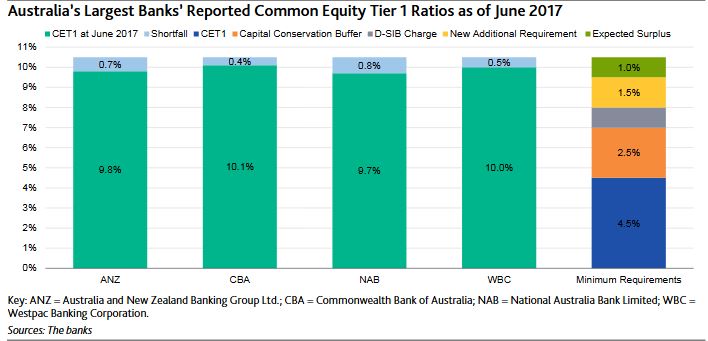Last Thursday, Commonwealth Bank of Australia announced that it had agreed to sell its Australian life insurance business, CommInsure Life,7 and its New Zealand life and health insurance businesses, Sovereign,8 to Hong Kong-based insurer AIA Group Limited for AUD3.8 billion ($3.0 billion). The transaction is credit positive for CBA because it will boost its capital adequacy. The deal also is credit positive for AIA because it will strengthen the insurer’s franchise and distribution in Australia and New Zealand with only a modest increase in financial leverage.
The sale price equals a price/book ratio of approximately 1.7x these businesses’ net tangible asset as of June 2017. The two companies also announced a 20-year bancassurance distribution agreements in both markets.
The announced sale comes at a time when mortgage risk weights and capital requirements are rising for Australian banks. In July 2017, the Australian Prudential Regulation Authority announced stricter capital requirements for Australian banks, including that Australia’s four largest banks, including CBA, raise their common equity Tier 1 (CET1) ratios to 10.5% by 1 January 2020.
These sales will put CBA in a strong position to meet this target. As of June 2017, CBA’s CET1 ratio was 10.1%. CBA estimates that the sale will release approximately AUD3 billion of CET1 capital, raising the bank’s fiscal 2017 (which ended 30 June 2017) CET1 ratio by approximately 70 basis points on a pro forma basis. The bank is currently dealing with allegations of non-compliance with Australia’s Anti-Money Laundering and Counter-Terrorism Financing Act that could result in a financial penalty that, depending on its size, could erode the bank’s capital position.
For AIA, the transaction will strengthen the insurer’s franchise and scale in Australia and New Zealand, where it will become those market’s largest life insurance provider. The 20-year bancassurance distribution agreements with CBA and ASB Bank Limited, which is CBA’s New Zealand subsidiary, will complement AIA’s distribution in these two markets, where AIA has traditionally focused on group business and the independent financial adviser channel.
AIA’s purchase will increase its financial leverage, although it will be small relative to its capitalization. The net cash outlay for the transaction will be only AUD2.1 billion ($1.7 billion), after taking into account reinsurance arrangements, and AIA’s strong capitalization should be able to easily absorb that amount. As of May 2017, AIA reported total equity attributable to shareholders of $38.3 billion and a solvency ratio of 427% at its main operating company, AIA Company Limited (financial strength Aa2 stable). AIA expects the transaction to be earnings accretive in the first year after deal completion.
From a strategic perspective, the transaction aligns AIA and CBA with their respective strengths in insurance product origination and distribution. AIA already has a strong track record in Australia and New Zealand and has strong capabilities in group-wide risk management, claims management and product development, resources on which it can leverage to further enhance its newly acquired businesses

